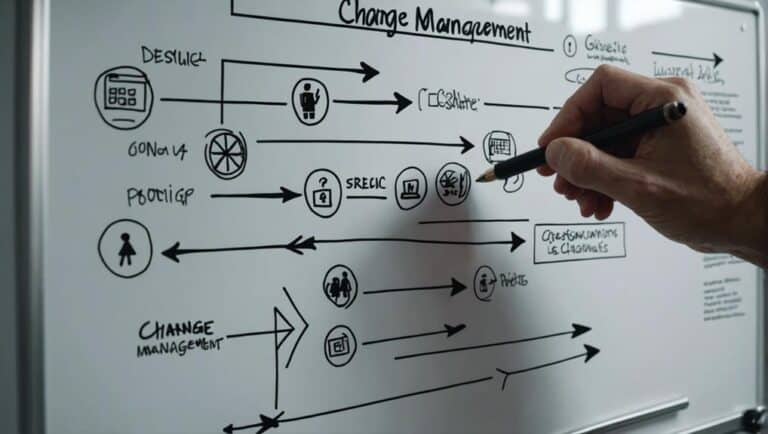Imagine a ship embarking on uncharted waters, navigating through turbulent seas while striving to reach a distant shore. Managing organizational restructuring is akin to steering through this challenging voyage, requiring adaptability, resilience, and strategic direction.
As you contemplate the intricate process of change management within your organization, consider how effective leadership and communication can serve as your compass in turbulent times.
By understanding the nuances of restructuring and embracing change management methodologies, you can unlock the potential for growth and success amidst uncertainty.
Key Takeaways
- Clear communication is vital for guiding individuals in restructuring.
- Proactively managing resistance aids in navigating organizational changes.
- Training equips employees with essential skills for successful restructuring.
- Identifying key stakeholders and engaging them is crucial for change management success.
Importance of Change Management in Restructuring
In organizational restructuring, the significance of change management can't be overstated as it plays a pivotal role in minimizing disruptions and fostering a smooth transition for all stakeholders involved. Change management is the compass that guides the organization through turbulent times, ensuring that every individual understands their roles and responsibilities in the restructuring process. An effective communication plan is at the heart of successful change management, equipping leaders with the tools to convey the reasons behind the changes and address any resistance that may arise.
Leadership must champion the cause of change readiness, setting the tone for the entire organization to embrace the restructuring positively. By acknowledging and addressing resistance promptly, change management creates a supportive environment where employees feel heard and valued. It's through these strategic interventions that organizations can navigate the complexities of organizational restructuring with agility and grace, ensuring that the impact isn't only minimized but also transformed into opportunities for growth and development.
Common Challenges in Organizational Change
Navigating through organizational restructuring poses numerous challenges, especially when met with resistance from employees hesitant to embrace change. In the change management process, leaders encounter hurdles in implementing organizational changes due to employees' resistance triggered by fear and uncertainty.
The brain's natural tendency to resist new ways of working to conserve energy further complicates the restructuring process. Understanding individual responses to change becomes pivotal as employees' reactions vary based on their brain connections, perceptions, skills, and past experiences.
Challenges arise not only from the organizational level but also from the personal level, making it essential for leaders to address both aspects effectively. By acknowledging and addressing these challenges head-on, leaders can better strategize ways to mitigate resistance, foster acceptance, and drive successful organizational change.
Embracing these difficulties as opportunities for growth and development can lead to a smoother transition and a more resilient organization in the long run.
Effective Change Management Strategies
Effectively managing change in organizational restructuring requires a proactive approach that prioritizes clear communication, targeted training, and strategic stakeholder engagement. To ensure successful implementation of change management strategies during the restructuring process, consider the following key elements:
- Implementing effective communication: Establishing transparent channels of communication is crucial to keep all employees informed and aligned with the goals of the restructuring process.
- Developing a comprehensive training program: Creating a structured training program will equip employees with the necessary skills and knowledge to navigate the changes effectively.
- Managing resistance through proactive strategies: Anticipate and address resistance by implementing proactive strategies that mitigate negative impacts on morale and productivity.
- Identifying key stakeholders: Identifying and engaging key stakeholders early on is essential for garnering support and ensuring the success of change initiatives.
- Creating a resistance management plan: Developing a plan to address resistance can help tackle challenges such as communication gaps and morale concerns effectively.
Implementing Change Management Plans
To successfully implement change management plans in organizational restructuring, it's crucial to establish clear communication channels, address resistance proactively, provide comprehensive training, and monitor progress effectively.
Communication is key during restructuring, ensuring that all stakeholders understand the reasons for the change and how it aligns with organizational goals. Managing resistance involves actively listening to concerns, providing support, and involving employees in the process.
Training and development programs play a vital role in equipping employees with the necessary skills to adapt to the changes effectively. Monitoring progress allows for adjustments to be made as needed, while evaluating the effectiveness of the change management plan ensures that it's on track to meet set objectives.
Setting measurable goals provides a clear roadmap for progress and helps in staying focused on achieving the desired outcomes. By implementing these strategies, you can navigate the complexities of organizational restructuring with confidence and agility.
Training for Organizational Restructuring
Training plays a crucial role in equipping employees with the necessary skills and knowledge to navigate and adapt to new roles and responsibilities during organizational restructuring. By implementing tailored training programs, organizations can enhance employee performance, increase productivity, and facilitate a smooth transition amidst change.
These programs, including workshops, seminars, and online courses, are designed to address specific areas of organizational restructuring, ensuring alignment with the overall goals of the change management process. Continuous learning opportunities embedded within the training foster a culture of growth and adaptability, crucial for employees to thrive in dynamic work environments.
Emphasizing skills development not only supports individuals in their current roles but also prepares them for future challenges, promoting resilience and agility within the organization. Through strategic training initiatives, organizations can empower their workforce to embrace change positively and contribute effectively to the success of the restructuring effort.
Frequently Asked Questions
How Do You Manage an Organisational Restructure?
To manage an organizational restructure effectively, focus on stakeholder engagement, communication strategy, gaining employee buy-in, implementing training programs, ensuring leadership support, managing resistance, aligning culture, planning transitions, setting performance metrics, and striving for continuous improvement.
What Are the 5 Key Principles of Change Management?
To manage change effectively, you must understand key principles: resistance management, communication strategies, employee engagement, leadership support, training programs. These elements, along with stakeholder involvement, cultural alignment, continuous improvement, change readiness, and risk assessment, drive successful transformation.
What Are the 7 R's of Change Management?
To navigate change successfully, grasp the 7 R's: Reason for change, expected Return, Risks involved, Resources needed, clear Roles & Responsibilities, and nurturing Relationships. These pillars foster effective transitions and pave the path for organizational evolution.
What Are 6 Steps to Effective Organizational Change Management?
To effectively manage organizational change, you must prioritize team engagement, implement a robust communication strategy, address resistance promptly, offer comprehensive training programs, secure leadership support, gather employee feedback, ensure cultural alignment, track performance metrics, involve stakeholders, and strive for continuous improvement.
Conclusion
In conclusion, navigating organizational restructuring with effective change management is like piloting a ship through turbulent waters.
By understanding the importance of stakeholder engagement, strategic planning, and clear communication, you can steer your organization towards success.
Embrace the challenges, adapt to the changes, and lead with empathy and confidence.
Remember, just as a skilled captain charts a course to calmer seas, you can guide your team through restructuring with resilience and determination.





